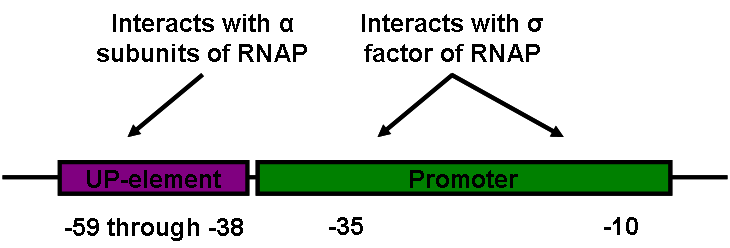Team:Virginia Commonwealth/Overview
From 2009.igem.org
GMcArthurIV (Talk | contribs) |
GMcArthurIV (Talk | contribs) |
||
| Line 1: | Line 1: | ||
<div id="header">{{Template:Team:Virginia_Commonwealth/Templates/Header}}</div> | <div id="header">{{Template:Team:Virginia_Commonwealth/Templates/Header}}</div> | ||
==Motivation== | ==Motivation== | ||
| + | The rational, forward engineering of genetically-encoded biological systems relies partly on 1) the generation of a multitude of genetic parts and 2) the sufficient characterization of these parts. This project aims to contribute to the advancement of synthetic biology by 1) generating and sharing a library of transcriptional enhancers called UP-elements (a new class of BioBrick parts), 2) characterizing strength of transcription initiation by measuring both mRNA and protein levels (by RT-PCR and flow cytometry, respectively) and 3) elucidating UP-element design principles. We propose our characterization methodology as a minimal measurement standard and hope that the results of this project will be useful to the community. | ||
| + | ==Project Overview== | ||
| + | We [[Team:Virginia_Commonwealth/Design| designed]] a variety of [[Team:Virginia_Commonwealth/BioBricks| UP-element BioBrick parts]] to serve as transcriptional enhancers and [[Team:Virginia_Commonwealth/Results| characterized]] them with our proposed [[Team:Virginia_Commonwealth/Methods| minimal measurement standard]]. | ||
| + | [[Image:VCU 2009 UP-element 1.png|thumb|center|400px|Figure 1: UP-element in context]] | ||
The rational, forward engineering of genetically-encoded biological systems relies partly on 1) the generation of a multitude of genetic parts and 2) the sufficient characterization of these parts. This project aims to contribute to the advancement of synthetic biology by 1) generating and sharing a library of transcriptional enhancers called UP-elements (a new class of BioBrick parts), 2) characterizing strength of transcription initiation by measuring both mRNA and protein levels (by RT-PCR and flow cytometry, respectively) and 3) elucidating UP-element design principles. We hope that the results of this project will be useful to the community. | The rational, forward engineering of genetically-encoded biological systems relies partly on 1) the generation of a multitude of genetic parts and 2) the sufficient characterization of these parts. This project aims to contribute to the advancement of synthetic biology by 1) generating and sharing a library of transcriptional enhancers called UP-elements (a new class of BioBrick parts), 2) characterizing strength of transcription initiation by measuring both mRNA and protein levels (by RT-PCR and flow cytometry, respectively) and 3) elucidating UP-element design principles. We hope that the results of this project will be useful to the community. | ||
| + | [[Image:VCU 2009 UP-element 2.png|thumb|center|400px|Figure 1: UP-element as an enhancer for transcription initiation]] | ||
==Safety== | ==Safety== | ||
#The nature of this project does not raise any unusual safety concerns. | #The nature of this project does not raise any unusual safety concerns. | ||
Revision as of 15:16, 21 October 2009
Contents |
Motivation
The rational, forward engineering of genetically-encoded biological systems relies partly on 1) the generation of a multitude of genetic parts and 2) the sufficient characterization of these parts. This project aims to contribute to the advancement of synthetic biology by 1) generating and sharing a library of transcriptional enhancers called UP-elements (a new class of BioBrick parts), 2) characterizing strength of transcription initiation by measuring both mRNA and protein levels (by RT-PCR and flow cytometry, respectively) and 3) elucidating UP-element design principles. We propose our characterization methodology as a minimal measurement standard and hope that the results of this project will be useful to the community.
Project Overview
We designed a variety of UP-element BioBrick parts to serve as transcriptional enhancers and characterized them with our proposed minimal measurement standard.
The rational, forward engineering of genetically-encoded biological systems relies partly on 1) the generation of a multitude of genetic parts and 2) the sufficient characterization of these parts. This project aims to contribute to the advancement of synthetic biology by 1) generating and sharing a library of transcriptional enhancers called UP-elements (a new class of BioBrick parts), 2) characterizing strength of transcription initiation by measuring both mRNA and protein levels (by RT-PCR and flow cytometry, respectively) and 3) elucidating UP-element design principles. We hope that the results of this project will be useful to the community.
Safety
- The nature of this project does not raise any unusual safety concerns.
- The local biosafety committee is the VCU School of Engineering Safety Committee.
- One of our advisors, Cindy Lovelace, serves on the committee and makes sure that our team followed all safety guidelines.
- Our new BioBrick parts should not raise any unusual safety concerns.
Background
Background papers related to synthetic biology
 "
"


